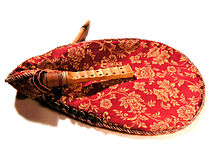Ceccola
The Ceccola is a bagpipe in Italy .
history
The Italian author Simone de 'Prodenzani (approx. 1351–1438) mentions in his work Il Saporetto , a collection of sonnets , a series of musical instruments played by his character Sollazzo. In the 31st sonnet there is talk of bagpipes. In one of the surviving manuscripts that was found in the Vatican library, he speaks of “la ciechola”, an instrument with which Sollazzo recites various works, the titles of which then follow. Another manuscript of the same work has "la sapognia", the zampogna , at this point , so that the instrument can be assigned to the bagpipes. This mention gave its name to the reconstruction of the Ceccola.
In the painting La Madonna dell'orchestra by Giovanni di Pier Matteo, called Boccati (1410–1486), an orchestra of angels plays on contemporary musical instruments. A bagpipe can also be seen here. This pictorial representation was the starting point for the reconstruction of the Ceccola.
reconstruction
In 2008 Walter Rizzo and Peter Rabanser reconstructed a Ceccola for a CD production. From a technical point of view, it is a bagpipe with whipping tongues , consisting of a sack, a blowing pipe and a chanter made of a single piece of wood with two longitudinal holes. This is a practice that has its roots in the Eastern Mediterranean and the Middle East, where many instruments of this type still exist today, including: a. Tulum (Turkey), Duda (Belarus, Ukraine, Hungary), Ney anban (Iran), Tsambouna (Greece), Mih, Diple (Dalmatia). In Western Europe there are only two instruments of this type, namely the Boha in Gascony and the Alboka in the Basque Country .
Ceccola polifonica
Shortly afterwards, an instrument was created on this basis, which was given the name ceccola polifonica . It is also made from a single piece of wood, but has three longitudinal holes on which the notes of a ninth are distributed. This makes it possible, similar to the baroque sordellina or the zampogna , to play in triads , the first (high) voice with the left hand, the second (middle) with the right, and the “bass”, which is limited to two notes , with the little finger of the right hand.
Web links
- Peter Rabanser, Walter Rizzo: The discovery of the “Ceccola” and its evolution - the “Ceccola polifonica”. In: Chanter. The Journal of the Bagpipe Society, Spring 2014, pp. 20-23
Individual evidence
- ↑ John Nadas: A cautious reading of Simone Prodenzani's Il Saporetto . In: Recercare , Vol. 10 (1998), pp. 23-38, here specifically pp. 32 and 35.


